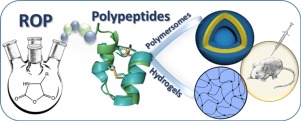Progress in Polymer Science ( IF 26.0 ) Pub Date : 2018-05-09 , DOI: 10.1016/j.progpolymsci.2018.05.001 Evelina Liarou , Spyridon Varlas , Dimitrios Skoulas , Chrisida Tsimblouli , Evangelia Sereti , Konstantinos Dimas , Hermis Iatrou

|
The synthesis of smart stimuli-responsive polymeric materials for nanomedicine applications has attracted the interest of a large number of scientists that focuses on the effective encapsulation of pharmaceutical compounds and control of their biodistribution. The development of multifunctional polymeric materials is mainly guided by the goal of achieving active compounds which selectively target the pathological sites, therefore minimizing systemic side effects. These materials are divided in two categories based on their mode of administration: the first is based on systemic administration, while the second relies on localized mode of action. Polymersomes are nanocarriers that are delivered through the blood compartment and are the best systems to carry both hydrophilic drugs in their interior hollow space or/and hydrophobic drugs encapsulated in their hydrophobic layer. Polymeric hydrogels on the other hand are systems for localized drug delivery of both kinds of pharmaceuticals, depending on their solubility. Even though a large number of polymeric materials that form either nanocarrier or hydrogel delivery systems has been investigated, a surprisingly small subset of these technologies has demonstrated potentially curative preclinical results, and fewer have progressed towards commercialization. One of the most promising classes of polymeric materials for drug delivery applications is polypeptides, which combine the properties of the conventional polymers with the 3D structure of natural proteins such as α-helices and β-sheets. In this article, the synthetic pathways followed to develop well-defined stimuli-responsive polymer delivery systems based on polypeptides that have been prepared through ring-opening polymerization (ROP) of N-carboxyanhydrides are reviewed, including a discussion of their in vivo and in vitro efficacy. This review is limited to systems presented over the last eighteen years.
中文翻译:

来自多肽基聚合物系统的智能聚合物小体和水凝胶,通过α-氨基酸N-羧基酐开环聚合反应形成。从化学到生物医学应用
用于纳米医学应用的智能刺激响应性高分子材料的合成吸引了众多科学家的兴趣,他们专注于药物化合物的有效封装及其生物分布的控制。多功能聚合物材料的开发主要受到以下目标的指导:获得选择性靶向病理部位的活性化合物,从而将全身性副作用降至最低。这些材料根据其给药方式分为两类:第一类基于全身给药,而第二种则依赖于局部作用模式。聚合物小体是通过血液隔室传递的纳米载体,是在其内部空腔中和/或在其疏水层中包裹疏水性药物的最佳系统。另一方面,聚合物水凝胶是根据其溶解性而用于两种药物的局部药物递送的系统。即使已经研究了形成纳米载体或水凝胶输送系统的大量聚合材料,但这些技术中出乎意料的一小部分却显示出了潜在的临床前治疗效果,并且很少有商业化的进展。用于药物递送的最有前景的聚合物材料类别之一是多肽,β-折叠。在本文中,所述合成途径,随后开发基于多肽已经通过开环聚合(ROP)的制备定义明确的刺激响应性聚合物的递送系统Ñ -carboxyanhydrides综述,包括它们的讨论在体内和在体外功效。这次审查仅限于过去18年提出的系统。











































 京公网安备 11010802027423号
京公网安备 11010802027423号